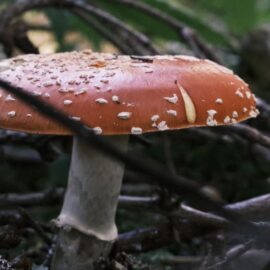

This article is an excerpt from the Shortform book guide to "Silent Spring" by Rachel Carson. Shortform has the world's best summaries and analyses of books you should be reading.
Like this article? Sign up for a free trial here.
Are there safe alternatives to pesticides? Can we use predators as pest control?
Rachel Carson argues that while pesticides use chemicals to control plant, insect, or animal populations, many biological control methods are just as effective, less expensive, and less harmful to the environment. While she does not advocate eliminating pesticides entirely, she suggests using them in more targeted ways.
Check out Carson’s suggestions for alternative methods of pest control.
Other Methods of Pest Control
Some alternatives to pesticides include tactics like introducing natural predators and diseases to an environment, sterilization, trapping, and so on. These methods would bring all the advantages of pesticide use for agriculture, beautification, and conservation without endangering the environment or people’s health.
(Shortform note: Carson’s suggested approach, of using pesticides sparingly alongside biological controls, is known as Integrated Pest Management and is advocated by both the US government and the United Nations’s Food and Agriculture Organization. Proponents of IPM argue that it not only does less damage to the environment but slows the development of chemical resistance among pests. Beyond biological and chemical controls, IPM integrates cultural controls (such as seasonal crop rotation to prevent a large community of pests from forming) and mechanical controls (such as installing ultraviolet light traps to attract beetles and flies away from plants).
Limited Spraying
At the time of Carson’s writing, pesticides were usually distributed from the air, sprayed indiscriminately over dozens or hundreds of acres at a time. Carson argues that a more effective method would be to apply the pesticides directly to the roots or nests of the species being targeted, keeping the poison relatively contained from the rest of the ecosystem. Though this approach would be more time-intensive, it would do less environmental damage and in many cases would be cheaper than dropping hundreds of gallons of pesticides at once.
Spraying individual weeds rather than an entire field would mean that existing plants could quickly fill in the gaps, rather than the whole area needing to be replanted. Similarly, spraying only the eggs of the target insect would prevent the spread of pesticides to its predators, which may not feed on the insect until it reaches the larval stage. Carson notes that such limited sprayings generally only need to be applied once or twice; the environment quickly stabilizes, with new species filling the niche of the old pests.
(Shortform note: While the methods Carson describes are effective in avoiding spray drift, the time and labor required make them less realistic pest-control options on farmland that’s hundreds of acres. Today, spraying remains the most popular pesticide application method, though hand sprayers and sprayers attached to vehicles have replaced aerial spraying in many places. Improvements to spraying technology tend to focus on controlling the size of the droplets produced—while smaller droplets can cover a larger area, larger droplets are less susceptible to spray drift.)
Introducing Predators and Diseases
Carson argues that because invasive species generally flourish due to a lack of natural predators, importing those predators or diseases can easily stabilize the population, so long as the new imports don’t threaten the ecosystem as a whole. This method has been proven many times to be effective—for example, the importation of the Tiphia moth and milky disease both cut down on the population of the Japanese moth in the US, and Argentine moths have been used to control the prickly pear cactus in Australia. Though more scientifically complicated, importation is generally less expensive than even a single pesticide campaign.
(Shortform note: The examples Carson gives were implemented by large organizations, but many biological controls are now available commercially. For example, gardeners can buy milky spore powder to use against Japanese beetles, as well as ladybugs to feed on aphids (though some entomologists advocate for attracting ladybugs native to your area rather than importing invasive ones) and bacteria like Streptomyces lydicus to control fungal root diseases.)
Other Biological Controls
Carson gives examples of several other methods of biological control, though she notes that many of these are still being tested and may prove more expensive and difficult to implement than pesticide campaigns. One example is the male sterilization technique, which involves capturing, sterilizing, then releasing large numbers of male insects, causing a number of eggs to go unfertilized and the population of the species to quickly reduce over a single generation. This method has been successfully tested against multiple fly species in North America and may prove effective against disease-carrying insects like the tsetse fly and mosquitoes.
Laboratory testing has also suggested that the behavior of insects can be modified using ultrasonic sound or the pheromones and other chemical attractants naturally produced by insects. Insects can be lured into traps using mating signals or encouraged to leave the area by false signals indicating the presence of predators. Carson notes that some of these techniques have been used to trap and kill gypsy moths, but only on a small scale and at great expense. Still, she argues that these methods are worth exploring as a form of insect population control that has a limited effect on the surrounding environment.
(Shortform note: The sterile insect technique Carson describes was successfully used to eradicate the screw-worm fly from North America and to control many other fly populations. However, sterilization must be conducted separately for every species, and so far the technique has proven less effective against mosquitoes. Similarly, while pheromone traps have proven effective in controlling various moth populations, they’ve been less effective against Japanese beetles, attracting far greater numbers of beetles to the area than they trap. Currently, the most popular method of biological pest control is the introduction of natural predators, such as birds.)

———End of Preview———
Like what you just read? Read the rest of the world's best book summary and analysis of Rachel Carson's "Silent Spring" at Shortform.
Here's what you'll find in our full Silent Spring summary:
- How pesticides threaten to devastate the environment and poison humans
- Why there should be stricter regulation of pesticides in the US
- How this 1962 book inspired the environmentalist movement of the 70s






